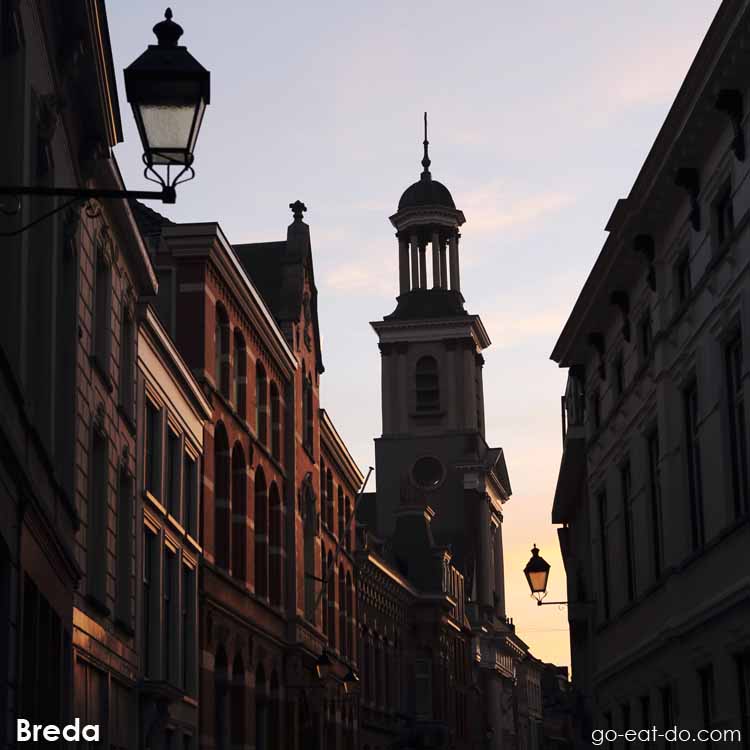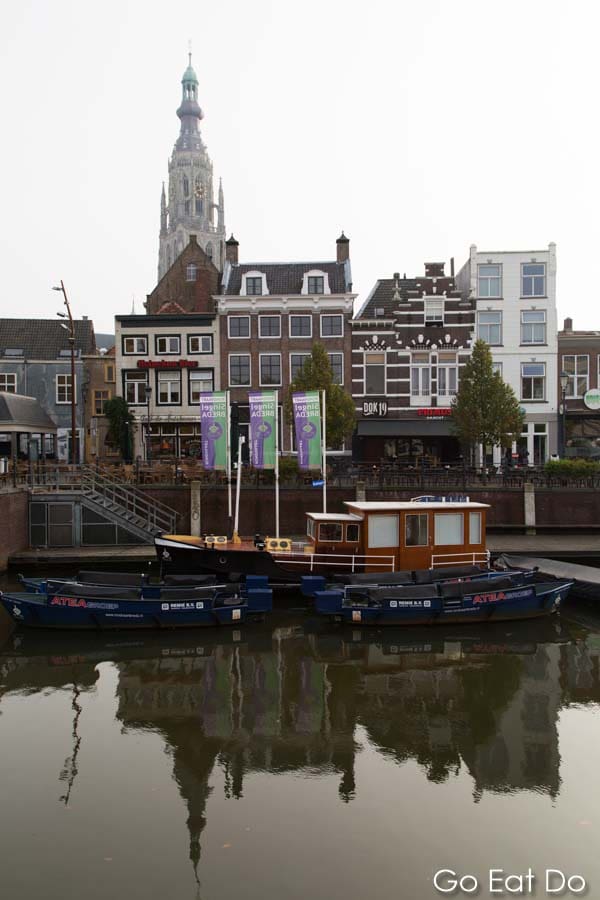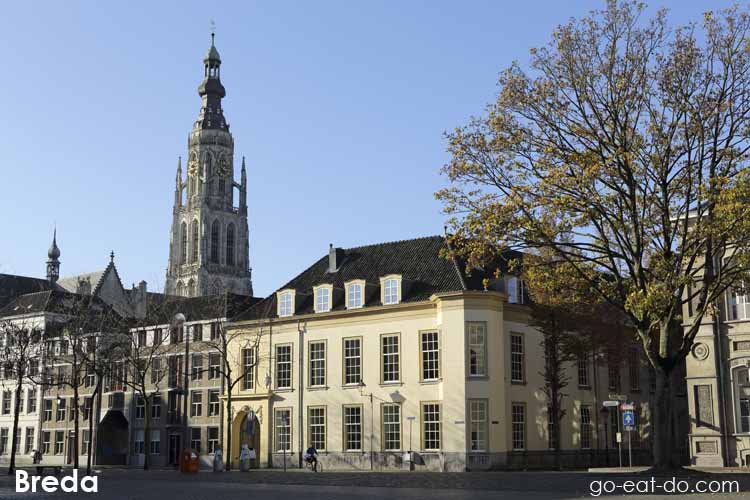Stuart Forster visits the Netherlands and outlines reasons to spend a weekend break in Breda.
Many international travellers will give you a blank look if you ask them to point out Breda on a map of the Netherlands. Dutch people, though, are well aware of the charms of this historic city and instinctively point towards the province of North Brabant in the country’s south.
Breda lies just a handful of kilometres from the border with Belgium. So close, in fact, that you can enjoy breakfast at a café-bar or restaurant at the Grote Markt – the cobbled marketplace in the heart of the city – then walk to the border and be back in time for lunch. After all, mealtimes are important here. Good food and drink play an important role in the rhythm of the day in Brabant, where people have a reputation for enjoying life.

A beer at the Café Beyerd
If you want to understand why, try popping into a traditional brown bar such as the Café Beyerd (Boschstraat 26; +) where you can order an espresso coffee to perk you up or select from a chalkboard menu featuring more than 100 different craft beers.
People are generally chatty as they relax over borrel, the late afternoon snack that’s enjoyed with a drink. Traditionally, borrel features dishes such as a cheese platter or a plate of bitterballen, a cross between a meatball and a croquette that’s deep-fried in breadcrumbs and served with mustard.
Perhaps inevitably, borrel is compared with afternoon tea in England. Coincidentally, the man whose spouse, Catherine of Braganza, introduced that tradition resided in Breda during his exile in the 1650s, while Oliver Cromwell governed England. The restoration of the monarchy was formulated in the Declaration of Breda, the document dating from 1660 that established the framework for the ascent of King Charles II to the English throne. That, though, is just one of several moments during which this small city helped shape Europe’s destiny.

Carnival season in Brabant
Instead of focusing on history, most locals like to live for the moment, particularly during the Carnival season, when many don colourful costumes and party on the streets. They’ll tell you this part of the Netherlands is very different to the north of the country.
People here pride themselves on their openness and warmth. It’s known as gezelligheid, a word that’s not readily translatable into English. It’s more than mere sociability, it’s something people strive to embrace.
Nights out in Breda, which has a multitude of bars, are known for being gezellig and draw people from around the Netherlands for weekend breaks. Most don’t need to travel for long to get home. Direct trains take just 69 minutes to reach central Amsterdam from Breda.
Key landmarks in Breda
The city centre is compact, making it easy to explore on foot. That’s one of the charms of this vibrant student city. The best-known landmark is the 97-metre tall tower of the 15th century Grote Kerk or Church of Our Lady, which dominates the urban skyline.
The airy, Gothic-style place of worship holds the tombs of several members of the House of Orange-Nassau, whose descendants constitute the modern-day Dutch royal family. In total, seventeen members of the dynasty are buried in the ornate Prinsencapel (Princes’ Chapel), whose centrepiece features a tomb guarded by four sculpted marble figures.

A short walk to Breda Castle
From the church, it’s a five-minute stroll to Breda Castle, which also has late medieval origins and underwent major expansion on the orders of the Counts of Orange-Nassau. Since 1826 the moated fortress has been utilised as a military academy, so isn’t open to the public. Its presence explains why you’ll see uniformed men and women cycling on Breda’s streets.
Back in 1581 the castle, and indeed the whole of the city, was besieged as Spain attempted to cling to its possessions in the Netherlands. A murderous rampage, known as the Fury of Haultepenne, followed Breda’s surrender. The event caused outrage and helped give the Dutch resolve in what would prove an eight-decade fight for independence.
The Surrender of Breda by Velázquez
Within Breda, you can still view key locations associated with that long struggle for nationhood. The Spanjaardsgat – a fortified gate by the harbour – is reputed to be the entry point for a barge in which 68 highly trained Dutch soldiers hid beneath turf before an operation to liberate the city in 1590.
Additionally, the lobby of the town hall holds a copy of Diego Velázquez’s epic oil painting, The Surrender of Breda, depicting the city changing hands again, in 1625. The highly valued original version of the work hangs in the Prado Museum in Madrid, Spain.

Stalls on Breda’s marketplace
As you stroll around the city centre you’ll see a number of commercial art galleries and artists’ supply shops dotted among the boutiques of Breda, which is a highly regarded shopping hub. Every Tuesday and Friday mornings market stalls are erected on the Grote Markt, and shoppers stream into the city to purchase cheeses, fresh fruit and vegetables plus fish.
Yet come the evening there’s no evidence they were there. Tables and chairs have replaced them on the cobbled square, in front of cafes and restaurants. Regardless of the ambient temperature, people can sit and enjoy spring evenings on the square thanks to outdoor heaters.

The Stedelijk Museum Breda
If it’s a rainy day and you enjoy graphic design and marketing, swing by the Stedelijk Museum Breda, which explores visual culture. The museum is located within a stylish modern building hidden behind the façade of a house dating from 1643.
Afterwards, you may think twice before sharing your selfies and photos from around Breda via social media. But in a photogenic city such as this one you’re sure to have plenty of pictures to choose from.
Further information
Looking for more things to see and do? See the Breda Tourist Information and Holland websites.
Photos illustrating this post are by Why Eye Photography.
Thank you for reading this post about a weekend break in Breda, the Netherlands. If you’re planning a visit to Breda, you might want to check out this post about De Beyerd beer cafe.
If you enjoyed this post why not sign up for the free Go Eat Do newsletter? It’s a hassle-free way of getting links to posts on a monthly basis.
‘Like’ the Go Eat Do Facebook page to see more photos and content.


